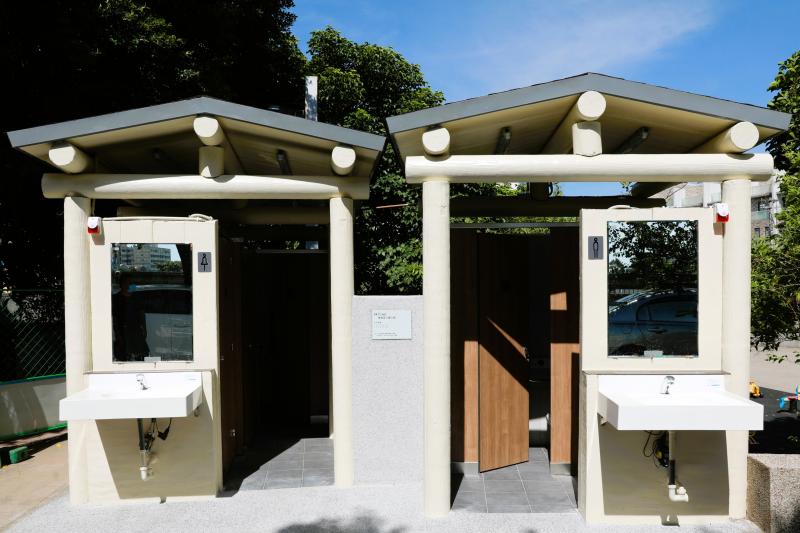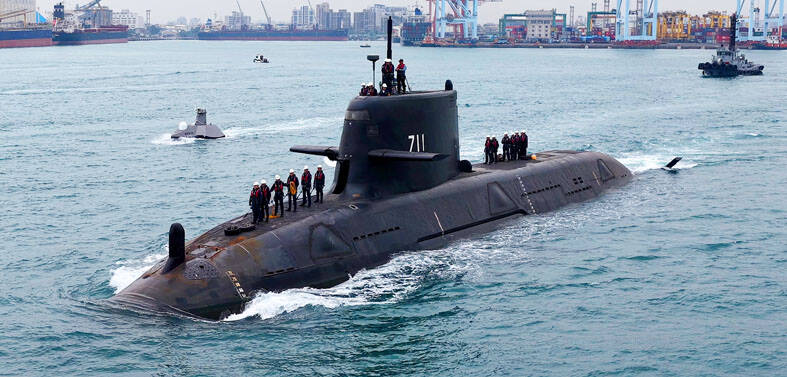Although the Environmental Protection Administration (EPA) has been telling people to flush toilet paper in toilets since 2017, roughly 55 percent of respondents to a survey still dispose of it in trash bins, the EPA said Thursday.
Asked why they continue to dispose of toilet paper in bins instead of flushing it, 44 percent of those responding in that way said they did so due to signage in place in public washrooms telling them not to flush anything in the toilet. Roughly 37 percent said they did so out of concern they would clog the toilet.

Photo: Chang-sheng, Taipei Times
EPA official Shih Sheng-chun (施勝鈞) said that such concerns are unnecessary, as all toilet paper commercially sold in Taiwan is safe to flush, as is indicated on its packaging.
Flushing toilet paper can reduce odor, prevent the growth of bacteria or the spread of infectious diseases, and increase the safety of cleaning staff and other users of public toilets, he said.
However, facial tissue, wet wipes, feminine hygiene products and other items not designed to be flushed should continue to be thrown into trash bins, he said, adding that if an excessive amount of toilet paper is used at once, that should still be thrown into a bin to prevent blockage.
Shih said the EPA would work with businesses operating public washrooms to address their concerns behind leaving signage in place advising against flushing toilet paper.

US climber Alex Honnold is to attempt to scale Taipei 101 without a rope and harness in a live Netflix special on Jan. 24, the streaming platform announced on Wednesday. Accounting for the time difference, the two-hour broadcast of Honnold’s climb, called Skyscraper Live, is to air on Jan. 23 in the US, Netflix said in a statement. Honnold, 40, was the first person ever to free solo climb the 900m El Capitan rock formation in Yosemite National Park — a feat that was recorded and later made into the 2018 documentary film Free Solo. Netflix previewed Skyscraper Live in October, after videos

NUMBERS IMBALANCE: More than 4 million Taiwanese have visited China this year, while only about half a million Chinese have visited here Beijing has yet to respond to Taiwan’s requests for negotiation over matters related to the recovery of cross-strait tourism, the Tourism Administration said yesterday. Taiwan’s tourism authority issued the statement after Chinese-language daily the China Times reported yesterday that the government’s policy of banning group tours to China does not stop Taiwanese from visiting the country. As of October, more than 4.2 million had traveled to China this year, exceeding last year. Beijing estimated the number of Taiwanese tourists in China could reach 4.5 million this year. By contrast, only 500,000 Chinese tourists are expected in Taiwan, the report said. The report

Temperatures are forecast to drop steadily as a continental cold air mass moves across Taiwan, with some areas also likely to see heavy rainfall, the Central Weather Administration (CWA) said. From today through early tomorrow, a cold air mass would keep temperatures low across central and northern Taiwan, and the eastern half of Taiwan proper, with isolated brief showers forecast along Keelung’s north coast, Taipei and New Taipei City’s mountainous areas and eastern Taiwan, it said. Lows of 11°C to 15°C are forecast in central and northern Taiwan, Yilan County, and the outlying Kinmen and Lienchiang (Matsu) counties, and 14°C to 17°C

STEERING FAILURE: The first boat of its class is experiencing teething issues as it readies for acceptance by the navy, according to a recent story about rudder failure The Hai Kun (海鯤), the nation’s first locally built submarine, allegedly suffered a total failure of stern hydraulic systems during the second round of sea acceptance trials on June 26, and sailors were forced to manually operate the X-rudder to turn the submarine and return to port, news Web site Mirror Daily reported yesterday. The report said that tugboats following the Hai Kun assisted the submarine in avoiding collisions with other ships due to the X-rudder malfunctioning. At the time of the report, the submarine had completed its trials and was scheduled to begin diving and surfacing tests in shallow areas. The X-rudder,